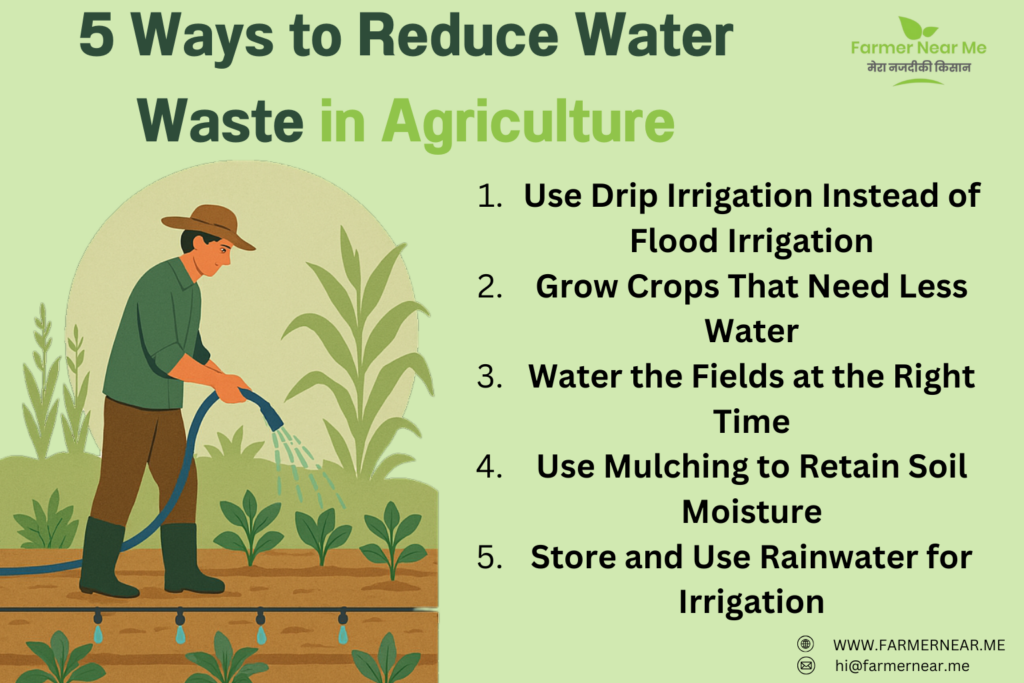Did you know water is the backbone of agriculture? In India, agriculture is one of the major sources of water waste. Many regions of India face severe water problems, such as water shortages, declining groundwater levels, and unpredictable monsoons. Traditional methods, like watering the whole field (flood irrigation) at once, often lead to excessive water loss through evaporation, runoff, and seepage, worsening the water shortage problem.
Increased food demand and changing weather conditions have made it essential for farmers to adopt water-saving methods to sustain agriculture for the long term. By using efficient irrigation systems, growing crops that require less water compared to other crops, and improving soil moisture retention, farmers can significantly reduce water waste while maintaining or even increasing crop yields.
In this blog, we will explore five highly effective and easy-to-implement methods that can help farmers optimize water use and reduce the waste of water during the cultivation of crops.
5 Ways to Reduce Water Waste in Agriculture
1. Use Drip Irrigation Instead of Flood Irrigation
What is Drip Irrigation?
Drip irrigation is a method in which water is supplied to the roots of crops directly through pipes with very small holes. Instead of flooding the entire field, water drips into the ground gradually so that plants get exactly what they need.

Why is Drip Irrigation Better than Flood Irrigation?
By providing water directly to the roots of crops, drip irrigation can save up to 50% of water compared to flood irrigation.
Drip irrigation also reduces weed growth since water only reaches crops, not the whole field.
It prevents soil erosion, which is caused by excessive water flow.
Improves the yield and quality of the crops by providing a steady water supply.
Who Should Use Drip Irrigation?
- Those farmers grow fruits, vegetables, and cash crops like sugarcane, banana, and cotton.
- Those farmers have limited water sources or farms in drought-prone areas.
-
Those farmers who grow less water require crops.
Tip: The Indian government provides subsidies on drip irrigation systems. Farmers can check and connect with the local agriculture offices for financial assistance regarding the information on the subsidies.
2. Grow Crops That Need Less Water
To reduce water waste, grow and select those crops that require less water compared to other crops, like millet.
Why Does Crop Choice Matter?
Not all crops require the same amount of water, but some crops require less amount of water compared to other crops. Select those crops that require less water in regions with low rainfall or water shortages, growing water-intensive crops like paddy (rice) or sugarcane may not be the best option.

Tip: Farmers should practice this method in the crop rotation, where they grow different crops in different seasons to improve soil health and reduce water dependency.
3. Water the Fields at the Right Time
Watering fields at the incorrect times may cause excessive water evaporation, and crops may not receive sufficient water. The proper time for irrigation is early in the morning or late in the evening.
- Morning & Evening Watering: Less evaporation, more water reaches the roots.
- Afternoon Watering: Over 30% of water evaporates with high temperatures.

Tip: Farmers can utilize soil moisture sensors to monitor how much water the soil actually requires before irrigating.
4. Use Mulching to Retain Soil Moisture
What is Mulching?
Mulching means covering the soil with a layer of organic materials (Such as dry leaves, straw, crop residues) or covering it with plastic sheets to prevent water evaporation.

Benefits of Mulching:
- Prevents soil from drying out too quickly.
- Controls weed growth, reducing competition for water.
- Reduces soil erosion during heavy rains.
- Increases soil fertility (if organic mulch is used).
Tip: Organic mulching is preferable for the purpose of enhancing soil health and improving soil fertility, whereas plastic mulching proves to be useful for the commercial agriculture of vegetables such as tomatoes, watermelon, and capsicum.
5. Store and Use Rainwater for Irrigation
Rather than depending only on groundwater or canals, farmers can collect rainwater and store it for their future use. This method is especially useful in dry areas where rainfall occurs in limited amounts.

Methods of Rainwater Harvesting:
- Farm Ponds – The Small ponds on the farm that can hold rainwater for irrigation the fields.
- Check Dams & Bunds – Check dams and bunds are structures that can stop rainwater from flowing away and help it to percolate into the ground.
- Rain Barrels – Rain barrels are simple tanks that collect rainwater from rooftops or open spaces and use it for irrigating the fields.
Tip: The government offers some schemes that can support rainwater harvesting projects. Farmers can check and connect with local agriculture departments for subsidies.
Final Words – Why Water Conservation Is Important
Water is the most valuable resource in agriculture. If we waste water today, our future generations will struggle to grow their food.
By following these simple but effective methods, farmers can:
- They can save water and reduce their irrigation costs.
- Increase their crop yields while consuming less water.
- Enhance farming sustainability in a changing climate.
By adopting small steps now, we can ensure the future of Indian farming. Start implementing these methods and observe the change in your farm’s productivity.
Are you already following any of these water-saving methods? Share your experience in the comments.

